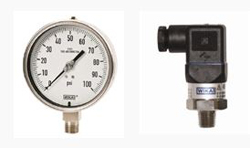Automated processes have rapidly become the norm with the advent of electrical pressure sensor and temperature sensor technology. Even so, mechanical instruments remain indispensable elements in automation. During power outages, plant engineers must revert to mechanical instruments to obtain reliable readings of important process information such as pressure and temperature. Since these instruments cannot be used for remote monitoring or control, plant engineers must use redundant instruments for local and remote monitoring of critical systems.
Proven Hybrid Instruments
Processes with local- and remote-mounted pressure instruments can now be replaced by a hybrid solution. intelliGAUGE, WIKA’s latest development in hybrid technology, combines the local reading analog display of a pressure gauge with the electrical output signal of a pressure transmitter. Having both features in one instrument can provide viable cost savings compared with using separate components. Hybrid instruments offer a practical and economical solution to a system requiring local and remote pressure instrumentation.

Function and Application
The WIKA intelliGAUGE hybrid instruments are a two-in-one combination of a mechanical pressure gauge and an electrical output signal that can be configured as an electric switch or as a pressure transmitter. Furthermore, intelliGAUGE has no mechanical linkage between the pressure sensor and the pressure gauge components. The pressure sensors are frictionless and wear-free.
intelliGAUGE is available for gauge and absolute differential pressure and, depending on application, for measuring ranges from 1” H2O to 100,000 psi.
Fig. 1: Bourdon Tube Pressure Gauges with Electrical Output Signal Stainless Steel Case Type PGT21
Switch contacts and close or open circuits depending on the pointer position of the intelliGAUGE. The contacts can be set over the entire scale range and are usually positioned underneath the dial. Regardless of the setting, the instrument pointer is free to move over the entire scale range.
The switch points can be adjusted through the window by a removable switch-adjustment tool. Switches can be set up so each deviation from this value triggers a switching process. For example, when the value is exceeded, the contact closes the circuit; when the value falls below the set point, the circuit is opened. The contact can also be used as a changeover contact. In this case, a circuit is opened and another one closes simultaneously when the set point is exceeded.
Four Types of Switch Contacts
Four different switch contacts are available for an electrical pressure sensor: magnetic snap-action, inductive, electronic, and reed switches. Magnetic snap-action and reed switches are passive switch contacts that require no power supply compared to the active inductive and electronic contacts.
Magnetic snap-action contacts are suitable for switching loads up to 30W/50 VA at a nominal operating voltage maximum of 250V. A higher load can be managed using a contact-protection relay, which prolongs the service life of the contact.
Reed switches have a contact rating of 10W at a voltage of 24V and operate on the principle of magnetic induction. As the pointer of the pressure measuring instrument approaches the switch point, the magnetic field will switch the circuit in the appropriate direction.
Inductive contacts are the first choice for incendive environments and do not require physical contact. A “flag” dips into an electrical sensor head and interrupts the electrical circuit, preventing sparks during contact.
Fig. 2: Inductive contact with three control heads
Using an integrated amplifier, electronic contacts can switch smaller capacities, which are common in programmable logic controllers (PLC). They also offer the same advantages as inductive contacts. They operate free of contact, without wear and without negative impact on the calibration of the measuring system.
Fig. 3: Model 232.50/30 and 233.50/30 with switch contacts Different Output Signals
intelliGAUGE instruments with an electronic output signal can be used in any location where measured values must be transmitted to a central control room. A rotary angle transmitter is non-contact and free from wear and friction. The transmitter determines the position of the pointer shaft and converts the corresponding measured value into one of the conventional electrical output signals: 0-10V, 4...20 mA, inversion, root extraction, square, linear, or non-linear. The signals are adjusted automatically along with the mechanical display.
Fig. 4: intelliGAUGE Bourdon Tube Pressure Gauges with Electrical Output Signal Stainless Steel, Safety Case Version Type PGT23.100
intelliGAUGE Applications
intelliGAUGE pressure measurement products intelliGAUGE pressure measurement products have numerous applications in process automation. Configurations are available for process environments including extreme ambient temperatures, caustic process mediums, and process vibration. A seal gauge is suitable for measuring low pressure in inches of H2O range. Instruments with lined wetted parts provide a durable solution for corrosive media. Some special instruments use switch contacts or analog output signals for measuring differential pressure.
intelliGAUGE, WIKA’s hybrid solution, represents a new standard for technology innovation in process automation. intelliGAUGE instruments are especially suitable for all applications that focus on reliability and cost effectiveness. Eliminating a redundant dual-instrument process and switching to a two-in-one hybrid solution saves space and cost.